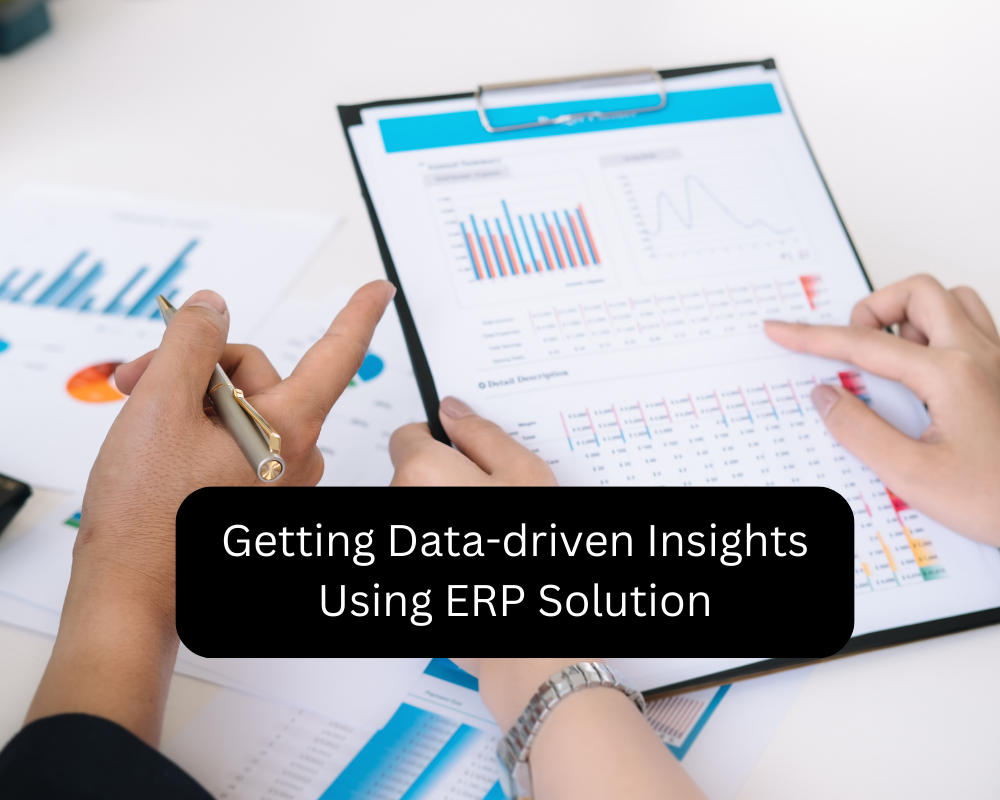What is an ERP Solution?
ERP Solution is a fully integrated system that allows businesses to automate and manage their back-office operations, and integrate all facets of their activities through a unified interface.
It includes a comprehensive set of modules such as inventory, distribution, human resources, marketing, supply chain, and finance, among others. An increasing number of businesses are adopting ERP to benefit from the free flow of information organisation-wide and transform the way they manage their business.
What are Data-driven Insights?
Modern companies are trying to be data-driven. Data-driven insights are details and summaries in the form of intuitive charts, reports, and customised dashboards that provide a comprehensive view of business operations.
A data-driven company is said to be a company that seamlessly accumulates organisation-wide data to develop the culture of making data-driven decisions, at all functionaries within the organisation, irrespective of their sizes.
To become a truly data-driven, a company will need to adopt the following practices:
- Replace paperwork with digital data
- Use the technology to accumulate data in digital form from all departments and functionaries
- Build a database that contains organisation-wide data with up-to-the-minute information
- Make sure that the database will apply to all members, regardless of their physical location and device type (such as computer, mobile, tablet, etc.)
- Use intuitive charts and reports to present the information in an easy-to-understand form
- Take timely backups to protect the integrity of the data and safeguard it against threat actors
Need for Data-driven Insights
There are different types of Data Analytics such as Descriptive Analytics which provides information about an event, Diagnostic Analytics which provides valuable insights into technicalities, and Prescriptive Analytics which aids with future courses of action.
Data-driven Insights help the businesses in various ways:
- It helps businesses process vast information to get the most compelling insights in a simple and easy form
- Helps businesses improve their efficiency, and productivity with strongly data-backed decisions
- It helps businesses become more customer-centric, and tailor their product offerings to the changing consumer needs
- Businesses get in a better position to identify and mitigate potential risks (whether economic, demand, reputational, or financial)
- Businesses can leverage the data and cutting-edge technology to find new revenue and growth opportunities.
How ERP Solution Helps Companies Get Data-driven Insights?
Centralised Data Repository
ERP builds a centralised repository of information accumulated from different sources and provides unprecedented visibility into your data to monitor the pulse and performance of the company.
- Access and data in real-time from a Single Source of Truth
- Integrate various aspects of your organisation from production, inventory, and sales to finance
- Get simple, sophisticated reports with complex data from disparate sources
- Improve departmental coordination and build a revenue-generating model
Reduces Data Redundancy
Data redundancy is the occurrence of multiple identical versions of the same data. It can cause a longer time to load the data, access to obsolete information, and confusion between the employees. The lack of access to correct and updated information can impact organisational productivity, efficiency, and difficulty in maintaining such a complex database.
- Reduces the chances of data corruption and integrity issues
- Access to the most accurate data across all departmental levels
- Reduces the wastage of time on lowering data discrepancies
- Minimises the potential errors and streamlines operations
Data Usability
Redundancies and inconsistencies in the data can lead to data usability issues. In the absence of true, accurate, and complete information, the organisation may suffer deterioration in the data quality and inability to use it for decision-making. ERP system builds a centralised system that fosters access to updated information on a timely basis to make truly data-driven decisions.
- Prevents information-overload
- Provides personalised reporting, customizable KPIs, and role-based dashboards
- Can be integrated with various other third-party tools for ongoing data sharing and making the data accessible in real-time
- The probability of your project’s success increases, and so does the experience of your consumers
Anticipate Customer Demands
ERP system helps companies forecast demands for their products which ultimately helps make informed decisions. For example, it takes into consideration the current market data, in addition to the historical data, to help you plan strategies that increase demand and grow your business.
- Your business better understands the requirements of your customers
- Make customer-centric decisions that help you build a brand reputation
- Make your customer service fast, efficient, and responsive
- Gain a competitive advantage over your competitors
Risk Management
Another incredible capability of ERP is to identify the immediate and future-centric risks faced by businesses. Such a Risk Management feature allows them to be less likely impacted by changes in the market, demand fluctuations, and other endless possibilities.
- Automatically monitor changes in the Government rules and regulations for new updates
- Your business lowers the chances of non-compliance with Government rules and regulations
- Your business follows the best security practices to keep your data safe
- You take the appropriate measures to lower the chances of potential data breaches
Resource Efficiency
ERP provides up-to-the-minute information about various business operations and allows you to better understand how the organisational resources are used. As a result, your business can save costs, and improve its productivity.
- Improve organisation productivity
- Get instant information about your stock levels
- Your business suffers lower overstocking and under-stocking
- Allocate your resources in an optimum manner to get the best results
Read: How Much Does It Cost to Develop an App Like Wish?
Predictive Machine Maintenance
With ERP, your business doesn’t need to manually track or schedule machine maintenance activities. ERP automates them so that your business experiences fewer machine downtimes, machine maintenance costs, lower business disruptions, and increased machine lifespan.
- ERP can be used in combination with various modern technologies such as IoT Sensors
- Monitor and predict equipment downtimes and failures
- Reduce the unplanned downtimes and business disruptions
- Improve machine lifespan and performance
Identify Changing Patterns
ERP builds a centralised database with access to the latest information. With access to up-to-date information, businesses are in a better position to reduce production defects, improve performance, and deal with sudden spikes
- Analyse past data and find unusual fluctuations
- Take measures to correct unusual fluctuations in the sales and revenues
- Provides businesses an opportunity to detect product defects and other issues in time
- Reduce the potential non-compliance risks with Government
Conclusion
ERP Solution improves the efficiency and performance of your business by providing strategic insights from data consolidated from disparate sources. It builds a unified system of information storage that provides statistical analysis and actionable reports to optimise business operations and reduce delays and inefficiencies.
Sage X3 provides the level of insights needed to stay ahead of the competitors and benefit from data visualisations, risk avoidance, and strategic decision-making, among others. Your business can leverage digestible facts about various aspects of your business operations through a unified and user-centric interface, and easy-to-understand and intuitive charts and reports.
Author’s Bio:
Sneha Rakte is a specialist in communication who excels at recognizing client requirements. She currently works with Sage Software Solutions, an industry leader in supplying small and medium-sized enterprises in India with high-quality ERP solutions and CRM solutions.


